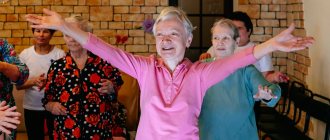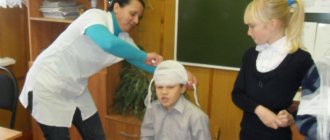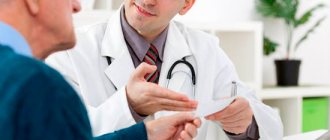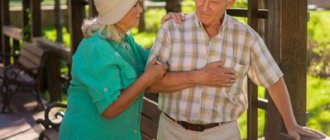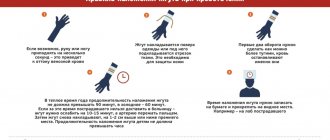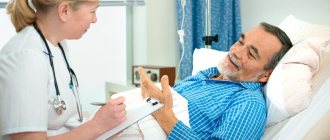A heart attack occurs when the blood supply to the heart is suddenly blocked by a blood clot. Many people recover fully from a heart attack, but there is a serious risk that the heart may stop beating - cardiac arrest. It is very important to provide prompt first aid in case of a heart attack. People with angina are more likely to have a heart attack. It occurs when the arteries leading to the heart narrow and the heart muscle cannot receive enough blood. It can occur not only during physical activity, but also during a period of rest (a more dangerous condition). Heart pain is usually a sharp pain in the chest, which may improve if you immediately calm down and take angina medicine. It may only last a few minutes. If the pain lasts longer, a heart attack develops.
What is a heart attack?
A heart attack is commonly referred to as a myocardial infarction.
This condition develops when blood flow in the vessels supplying the heart muscle is impaired. For example, due to a sharp spasm or blockage of blood vessels with a blood clot or accumulation of cholesterol. From a lack of oxygen, a section of the heart muscle begins to die. This causes chest pain and cardiac dysfunction. Myths about heart disease
Heart disease is the leading cause of death worldwide. However, myths about cardiovascular disease persist. Test your own knowledge.
Who is having seizures?
The risk of a heart attack increases during periods of unstable disease, in the off-season, and at high atmospheric pressure. Statistics show that the most susceptible to attacks are:
- middle-aged men (40-60 years old);
- having excess weight;
- people who do not want to give up smoking and alcohol;
- “experienced” hypertensive patients;
- persons suffering from coronary heart disease;
- patients with initial manifestations of heart failure;
- sensitive people who do not tolerate stressful situations well;
- persons who voluntarily stopped taking medications.
How dangerous is a heart attack?
Heart attacks often lead to cardiac arrest
.
At the same time, a person with a heart attack has very little chance of surviving without qualified care in a hospital. That is why, if symptoms of a heart attack develop, you should immediately
call an ambulance, even if the person himself thinks that nothing serious is happening.
Even minor discomfort in the chest can be symptoms of a developing myocardial infarction. Up to a third of heart attacks are not accompanied by severe pain, and people notice heart problems too late
. In addition, women tend to underestimate discomfort in the chest. According to the observations of doctors, even in the hospital emergency room they rarely complain of pain during a heart attack.
Characteristics of typical heart pain
In another way, such pain is called “angina pectoris” or angina pectoris.
- There is a feeling of compression behind the sternum or on the left; due to the pressing pain, the patient cannot take a deep breath.
- It radiates to the left shoulder, shoulder blade, less often to the throat, lower jaw.
- Associated with physical activity, the condition improves with rest.
- There is a feeling of lack of air, the patient cannot lie down, tries to sit up, gasps for air.
- Rhythm interruptions are often a concern.
- Pallor of the face and cold sweat appear.
- Accompanied by a feeling of fear of death.
- Lasts from 5 minutes to half an hour.
If the attack depends on physical activity, this form is referred to as angina pectoris. In the more severe version, paroxysmal pain occurs at night, without any exertion. This is angina at rest. A change in the form of attacks indicates a possible pre-infarction condition and requires prompt treatment.
If you experience discomfort in the chest area, call an ambulance immediately if:
- You are over 40 years old and have one or more risk factors for heart disease: a family history of heart attacks, smoking, obesity, a sedentary lifestyle, high blood cholesterol, diabetes.
- Chest pain can be described as tight, heavy and squeezing.
- The pain is accompanied by weakness, nausea, shortness of breath, sweating, dizziness or fainting.
- The pain radiates to the shoulders, arms, neck or jaw.
- The pain is accompanied by a feeling of despair and doom.
- The pain intensifies within 15-20 minutes.
conclusions
The favorable prognosis after a heart attack is lower in women than in men. With age, the level of estrogen in the blood decreases in the weaker sex, and background pathology (hypertension, diabetes, obesity) is often added. Failure to seek help in a timely manner and attempts at self-medication significantly reduce the effectiveness of therapy and worsen the patient’s quality of life, increasing the degree of disability. Elderly women should be especially attentive to their health, undergo regular medical examinations, and lead an active lifestyle. If two or more warning signs of a heart attack appear, consult a doctor immediately. Timely diagnosed early signs of a heart attack in women and first aid provided in full can save lives.
What to do while waiting for help:
1. Take a sitting or reclining position and relax
.
The greater the load on the heart during a heart attack, the more severe the consequences will be. 2. Unbutton your collar, loosen your belt, ask to open the windows if the room is stuffy. 3. Place a nitroglycerin tablet under your tongue and dissolve it slowly. only take one
before the ambulance arrives , as this medicine can cause a sharp drop in blood pressure in some people.
4. Do not take coffee, alcohol
and other people's “heart” medications. Ethanol, caffeine, and substances found in medications that are not intended for you can be deadly if you have a heart attack.
Attack with hypertension
In the cardiac course of hypertension, pain in the heart occurs during each hypertensive crisis. This condition is characterized by:
- simultaneous headaches in the back of the head or crown;
- dizziness;
- noise in ears;
- muscle tremors;
- visual impairment;
- nausea and vomiting;
- paresthesia (“goosebumps”) on the skin of the arms and legs;
- excitement or, conversely, inhibition of consciousness.
Without assistance, the crisis lasts from several hours to a day.
Symptoms suggestive of non-cardiac causes
You should not try taking heart medications if you have the following symptoms:
- the pain is short-term, stabbing, goes away on its own;
- intensifies with deep breathing, movement of the torso, arms;
- there is pain when pressing along the lower edge of the costal arch;
- At the same time, heartburn, belching, and a tendency to loose stools occur;
- constant aching pain that does not depend on physical activity.
With such symptoms, there is more evidence to suggest osteochondrosis of the thoracic spine, intercostal neuralgia, chest injury, stomach problems, and cardioneurosis.
In our country, up to 80% of deaths occur outside of medical organizations - at home, at work, in the country, in public and other places. Most of them occur suddenly or by the mechanism of sudden death. However, with knowledge of simple first aid techniques on the part of people surrounding a person who finds himself in such a critical condition, as well as everyone’s knowledge of first self-help measures, can in most cases save the patient’s life. In addition, statistics show that many patients themselves (or their relatives) call an emergency doctor late, which delays and reduces the likelihood of rescue.
This leaflet is addressed to almost all people, but especially to patients with cardiovascular diseases, with a high and very high risk of their development and complications, and their relatives and friends, since it is known that often a life-threatening complication, dangerously fatal, can be the first symptom of these diseases.
The leaflet is aimed at preventing and reducing the likelihood of fatal outcomes in life-threatening conditions; it describes clinical symptoms in relation to which one should be especially wary, and provides rational first-aid techniques while waiting for the arrival of an emergency physician.
- FIRST AID FOR HEART ATTACK
characteristic signs (symptoms) of a heart attack (myocardial infarction)
- sudden (paroxysmal) pressing, squeezing, burning, aching pain in the chest (behind the sternum) lasting more than 5 minutes;
- similar pains are often observed in the area of the left shoulder (forearm), left shoulder blade, left half of the neck and lower jaw, both shoulders, both arms, the lower part of the sternum along with the upper abdomen;
- lack of air, shortness of breath, severe weakness, cold sweat, nausea often occur together sometimes followed or preceded by discomfort/pain in the chest
- It is not uncommon for these manifestations of the disease to develop against the background of physical or psycho-emotional stress, but more often with some interval after them.
Uncharacteristic signs that are often confused with a heart attack:
- stabbing, cutting, pulsating, boring, constant aching pain for many hours and not changing its intensity in the heart area or in a specific clearly defined area of the chest
Algorithm of urgent actions:
If you or someone else suddenly has the above characteristic signs of a heart attack, even with weak or moderate intensity, which last more than 5 minutes, do not hesitate, immediately call an ambulance team. Do not wait more than 10 minutes - in such a situation it is life-threatening.
If you have symptoms of a heart attack and there is no way to call an ambulance, then ask someone to take you to the hospital - this is the only right decision. Never drive yourself unless you have no other choice.
In the most optimal scenario, if a heart attack occurs, you must follow the instructions received from your attending physician; if there are no such instructions, then you must act according to the following algorithm:
- Call an emergency medical team.
- Sit (preferably in a chair with armrests) or lie in bed with the head of the bed raised, take 0.25 g of acetylsalicylic acid (aspirin) (chew the tablet, swallow) and 0.5 mg of nitroglycerin (put the tablet/capsule under the tongue, first bite the capsule, do not swallow); free your neck and provide fresh air (open the vents or windows).
- If after 5-7 minutes. After taking acetylsalicylic acid (aspirin) and nitroglycerin, pain persists, you need to take nitroglycerin a second time.
- If pain persists 10 minutes after taking the second dose of nitroglycerin, it is necessary to take nitroglycerin a third time.
- If after the first or subsequent doses of nitroglycerin there is severe weakness, sweating, shortness of breath, you need to lie down, raise your legs (on a bolster, etc.), drink 1 glass of water and then, as with a severe headache, do not take nitroglycerin.
- If the patient has previously taken medications that lower blood cholesterol levels from the statin group (simvastatin, lovastatinfluvastatin, pravastatin, atorvastatin, rosuvoastatin), give the patient his usual daily dose and take the drug with you to the hospital.
Attention! A patient with a heart attack is strictly forbidden to get up, walk, smoke or eat until the doctor’s special permission;
You should not take aspirin (acetylsalicylic acid) if you are intolerant to it (allergic reactions), as well as with obvious or worsening peptic ulcers of the stomach and duodenum;
Nitroglycerin should not be taken if there is severe weakness, sweating, or if there is severe headache, dizziness, or acute impairment of vision, speech, or coordination of movements.
Forms of atrial fibrillation
Atrial fibrillation (atrial fibrillation) can occur in several variants (forms):
- paroxysmal form: usually the patient has a normal sinus rhythm, but periodically it “breaks down” and an attack of irregular heartbeat develops, usually rapid;
- persistent form: the patient’s usual rhythm is atrial fibrillation, but sometimes due to unknown reasons, his normal heartbeat is restored for some time;
- permanent form: only an irregular heartbeat is recorded, sinus rhythm is not restored.
And also, depending on the average pulse frequency, tachysystolic, normo- and bradysystolic forms of atrial fibrillation are distinguished.
Tachysystolic form - an increase in the average heart rate of more than 100 per minute.
Normosystolic form with heart rate from 60 to 100 beats,
Bradysystolic form is a decrease in heart rate of less than 50 - 60 per minute.
In the paroxysmal course of MA, attacks usually have a high heart rate.


